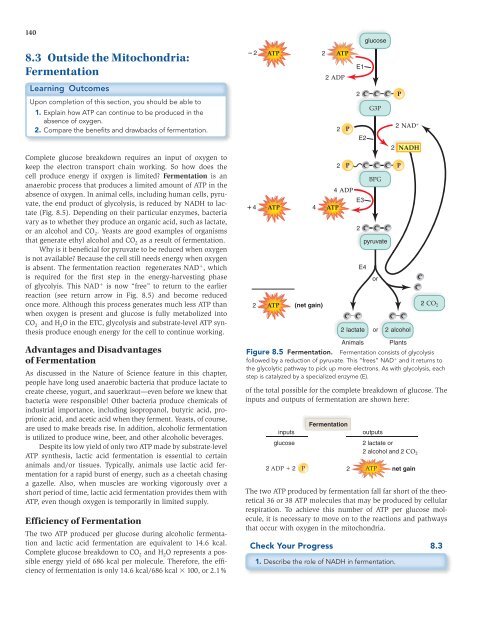Cellular Respiration
Cellular Respiration
Cellular Respiration
Create successful ePaper yourself
Turn your PDF publications into a flip-book with our unique Google optimized e-Paper software.
140<br />
8.3 Outside the Mitochondria:<br />
Fermentation<br />
Learning Outcomes<br />
Upon completion of this section, you should be able to<br />
1. Explain how ATP can continue to be produced in the<br />
absence of oxygen.<br />
2. Compare the benefi ts and drawbacks of fermentation.<br />
Complete glucose breakdown requires an input of oxygen to<br />
keep the electron transport chain working. So how does the<br />
cell produce energy if oxygen is limited? Fermentation is an<br />
anaerobic process that produces a limited amount of ATP in the<br />
absence of oxygen. In animal cells, including human cells, pyruvate,<br />
the end product of glycolysis, is reduced by NADH to lactate<br />
(Fig. 8.5). Depending on their particular enzymes, bacteria<br />
vary as to whether they produce an organic acid, such as lactate,<br />
or an alcohol and CO 2 . Yeasts are good examples of organisms<br />
that generate ethyl alcohol and CO 2 as a result of fermentation.<br />
Why is it benefi cial for pyruvate to be reduced when oxygen<br />
is not available? Because the cell still needs energy when oxygen<br />
is absent. The fermentation reaction regenerates NAD + , which<br />
is required for the fi rst step in the energy-harvesting phase<br />
of glycolyis. This NAD + is now “free” to return to the earlier<br />
reaction (see return arrow in Fig. 8.5) and become reduced<br />
once more. Although this process generates much less ATP than<br />
when oxygen is present and glucose is fully metabolized into<br />
CO 2 and H 2 O in the ETC, glycolysis and substrate-level ATP synthesis<br />
produce enough energy for the cell to continue working.<br />
Advantages and Disadvantages<br />
of Fermentation<br />
As discussed in the Nature of Science feature in this chapter,<br />
people have long used anaerobic bacteria that produce lactate to<br />
create cheese, yogurt, and sauerkraut—even before we knew that<br />
bacteria were responsible! Other bacteria produce chemicals of<br />
industrial importance, including isopropanol, butyric acid, proprionic<br />
acid, and acetic acid when they ferment. Yeasts, of course,<br />
are used to make breads rise. In addition, alcoholic fermentation<br />
is utilized to produce wine, beer, and other alcoholic beverages.<br />
Despite its low yield of only two ATP made by substrate-level<br />
ATP synthesis, lactic acid fermentation is essential to certain<br />
animals and/or tissues. Typically, animals use lactic acid fermentation<br />
for a rapid burst of energy, such as a cheetah chasing<br />
a gazelle. Also, when muscles are working vigorously over a<br />
short period of time, lactic acid fermentation provides them with<br />
ATP, even though oxygen is temporarily in limited supply.<br />
Efficiency of Fermentation<br />
The two ATP produced per glucose during alcoholic fermentation<br />
and lactic acid fermentation are equivalent to 14.6 kcal.<br />
Complete glucose breakdown to CO 2 and H 2 O represents a possible<br />
energy yield of 686 kcal per molecule. Therefore, the effi -<br />
ciency of fermentation is only 14.6 kcal/686 kcal × 100, or 2.1%<br />
-2<br />
ATP<br />
+4 ATP<br />
4<br />
2<br />
ATP<br />
(net gain)<br />
2 ATP<br />
2 ADP<br />
ATP<br />
2 P<br />
2 P<br />
4 ADP<br />
C C C C<br />
of the total possible for the complete breakdown of glucose. The<br />
inputs and outputs of fermentation are shown here:<br />
Fermentation<br />
inputs outputs<br />
glucose<br />
2 lactate or<br />
2 alcohol and 2 CO2 2 ADP +2 P 2 ATP net gain<br />
The two ATP produced by fermentation fall far short of the theoretical<br />
36 or 38 ATP molecules that may be produced by cellular<br />
respiration. To achieve this number of ATP per glucose molecule,<br />
it is necessary to move on to the reactions and pathways<br />
that occur with oxygen in the mitochondria.<br />
Check Your Progress 8.3<br />
1. Describe the role of NADH in fermentation.<br />
2<br />
2<br />
glucose<br />
G3P<br />
BPG<br />
pyruvate<br />
P<br />
2 NAD ;<br />
2 NADH<br />
Animals Plants<br />
Figure 8.5 Fermentation. Fermentation consists of glycolysis<br />
followed by a reduction of pyruvate. This “frees” NAD + and it returns to<br />
the glycolytic pathway to pick up more electrons. As with glycolysis, each<br />
step is catalyzed by a specialized enzyme (E).<br />
E1<br />
E2<br />
E3<br />
E4<br />
C C C<br />
C C C<br />
C C C<br />
or<br />
P<br />
2 lactate or 2 alcohol<br />
C<br />
C<br />
2 CO 2

















